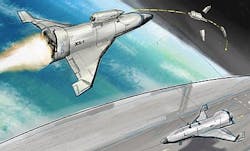DARPA issues first-phase solicitation for XS-1 hypersonic space plane for deploying satellites
Officials of the U.S. Defense Advanced Research Projects Agency (DARPA) in Arlington, Va., released a formal solicitation this week (DARPA-BAA-14-01) for the initial phase of the XS-1 Experimental Spaceplane project to design a reusable spacecraft to support not only next-generation launch for government and commercial satellites, but also global-reach hypersonic and space-access aircraft.
The XS-1 program seeks to lower satellite launch costs by developing a reusable hypersonic unmanned vehicle with costs, operation, and reliability similar to traditional aircraft, DARPA officials say.
The vehicle is envisioned to operate from a clean pad, with a small ground crew, and inexpensive infrastructure to enable routine daily operations and flights from a wide range of locations. XS-1 seeks to deploy small satellites faster and more affordably than is possible today, while demonstrating technology for next-generation space and hypersonic flight for government and commercial users.
“We want to build off of proven technologies to create a reliable, cost-effective space delivery system with one-day turnaround,” says Jess Sponable, the DARPA program manager heading the XS-1. program. “How it’s configured, how it gets up, and how it gets back are pretty much all on the table.”
XS-1 envisions that a reusable first stage would fly to hypersonic speeds at a suborbital altitude, when one or more expendable upper stages would separate and deploy a satellite into low-Earth orbit.
The reusable hypersonic aircraft then would return to earth, land, and be prepared for the next flight. Key XS-1 technical goals include flying 10 times in 10 days, achieving speeds faster than Mach 10 (7,600 miles per hour) at least once and launching a payload to orbit. The program also seeks to reduce the cost of access to space for small payloads by at least a factor of 10, to less than $5 million per flight.
XS-1 would complement the DARPA Airborne Launch Assist Space Access (ALASA) program, which already is researching satellite launch systems that aim to be fast, more convenient, and affordable. ALASA seeks to propel 100-pound satellites into orbit for less than $1 million per launch using low-cost, expendable upper stages launched from conventional aircraft.
The first phase of the XS-1 program, for which the solicitation released this week applies, is to perform risk reduction and design. If approved the program would to proceed to the second and third phases to fabricate and fly an experimental autonomous spaceplane.
DARPA officials say they expect to make several contract awards for the XS-1 first phase, and spend about $14 million. If the program moves to the second and third phases, money available to contractors could increase to about $140 million.
Each phase 1 system contractor may receive contracts as large as $3 million, with options for an additional $1 million. If DARPA moves to the second and third phases, officials will downselect to one contractor.
The program's 13-month first phase is to evaluate the technical feasibility and methods for building a reusable space plane. It will develop the XS-1 demonstration concept; identify core component technologies; conduct critical risk reduction; and develop a technology maturation plan for flight demonstration and validation of system capabilities.
Companies interested should send proposals to DARPA no later than 16 Jan. 2014. Questions are due by 22 Nov. 2013.
For questions or concerns email Jess Sponable, the XS-1 program manager, at [email protected]. The XS-1 solicitation and other information is online at https://www.fbo.gov/spg/ODA/DARPA/CMO/DARPA-BAA-14-01/listing.html.
